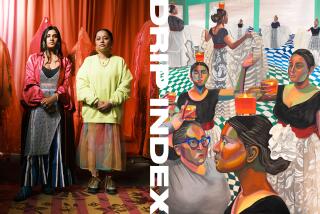The real art pioneers of downtown L.A. and the wild, barrier-busting shows that made the Arts District
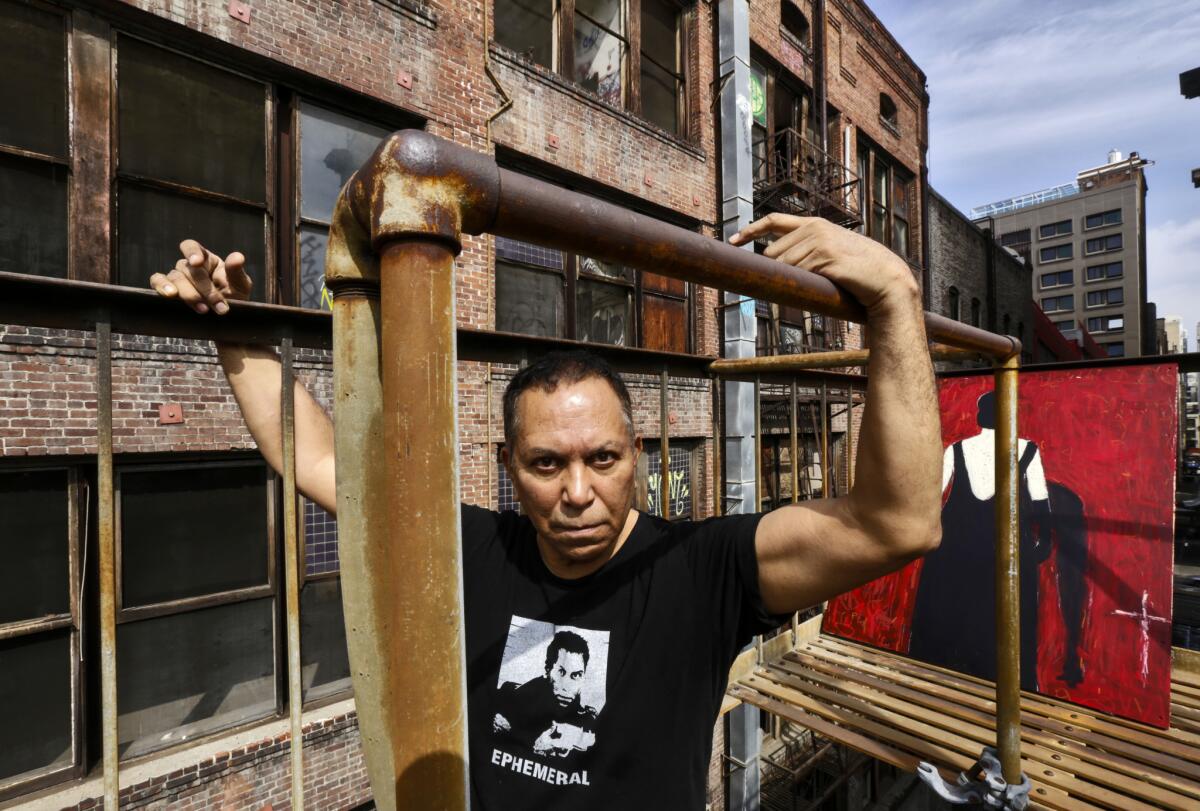
Gronk Nicandro is a performance artist, painter and set designer who has lived in downtown Los Angeles since the late 1970s. He also helped found Los Angeles Contemporary Exhibitions, whose first two galleries were in downtown Los Angeles.
Jean Milant could have headed west when he moved his gallery and print shop from a Hollywood storefront. Instead, he decided to go east, away from the art world establishment, to set up his Cirrus Gallery and Cirrus Editions, the esteemed artist prints company, in a space that once housed a municipal utility on the eastern edge of downtown Los Angeles.
It’s a familiar-sounding story in 2016. All sorts of arts spaces have moved into the light industrial area downtown: The Box Gallery in 2007, the Wulf performance space in 2008, CB1 Gallery in 2010, followed by Night Gallery in 2013 and the Mistake Room and Francois Ghebaly in 2014. This weekend, Hauser Wirth & Schimmel, the L.A. outpost of the venerable Swiss gallery, opens its doors on East 3rd Street in a Home Depot-sized space. With the ambitions of a small museum, the gallery in a former flour mill will also contain education spaces, a research lab and a big-deal restaurant.
See more of Entertainment’s top stories on Facebook >>
This blossoming has led to an avalanche of articles describing the “forbidding allure” of the “new” downtown art scene, under headlines such as “Downtown Goes From Bleak to Chic.”
Largely overlooked is downtown’s long history as a place where art has been made and shown. Milant’s big move for Cirrus Gallery? That happened in 1979.
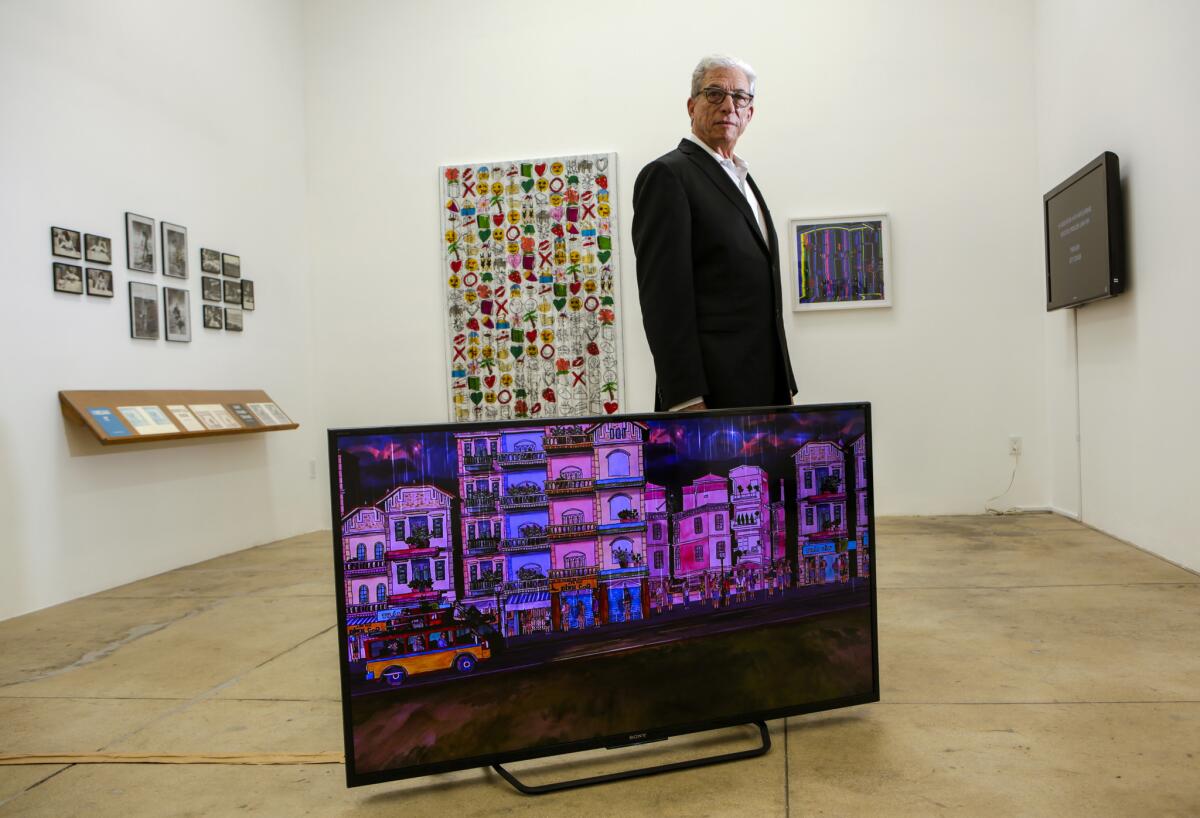
Jean Milant is the owner of Cirrus in Los Angeles, which has operated in downtown since 1979..
In those years, much of the art world action was centered on La Cienega Boulevard on the fringes of West Hollywood. It was there that the important Los Angeles galleries of the day — Nicholas Wilder, Margo Leavin and Rosamund Felsen — had set up shop.
But Milant was intrigued by the 13,000-square-foot industrial space he found on South Alameda Street for $1,200 a month (about $3,900 in today’s dollars).
“Regardless of what everyone said, I always thought that Los Angeles had to have a center,” he says of the decision. “Downtown was that center.”
He moved his gallery and presses into the first floor and used the top floor as his living quarters. His neighbors were a truck stop and various tin warehouses. Just down the block was the manufacturing headquarters of the century-old Los Angeles Soap Co., which produced White King D detergent. (Slogan: “Live it up white!”)
For me, downtown has always been one big bus stop, where you see a cross-section of mankind.
— Gronk Nicandro, an artist and set designer
Downtown was then a rather somnolent area, its historic core and business districts attracting rushes of people during office hours; the rest of it, half boarded up. Even so, Milant was not alone.
Amid all that 1970s urban decay was a hive of artistic activity that ran the gamut from D.I.Y. to high-falutin’ — from the art-punk scene run by artist Marc Kreisel at Al’s Bar on Traction Avenue to the experimental shows organized by Los Angeles Contemporary Exhibitions to the more polished ARCO Center for Visual Art on Flower Street, a not-for-profit gallery space operated by the oil company.
“There was a lot of energy,” says Milant, who over the decades has exhibited works by seminal California artists in his space — from conceptualist John Baldessari to the maestro of noir pop, Ed Ruscha. “It was the ‘70s, and it’s this period when artists are coming out of art school. You have a lot of young people opening galleries and staging events and doing shows.”
These vital spaces were the precursors to the tornado of artdom that is currently hitting downtown. Yet even they were not the first artists to find a home here.
This is, after all, the neighborhood that was home to early 20th century show palaces, where John Fante wrote “Ask the Dust” and Kent Mackenzie filmed his 1961 classic “The Exiles” about young and alienated Native Americans on the streets of downtown.
For a time in the 1970s and ‘80s, the downtown L.A. art scene was so happening that news reports regularly referred to the area as the “SoHo of the West” — home to dozens of galleries and nonprofit art spaces.
In 1985, Times art critic William Wilson wrote of the area: “Nothing in recent years has so beguiled the indigenous cultural imagination as the vision of downtown Los Angeles transformed into a glittering art Mecca.” It’s a sentence that could’ve been written last week.
“That’s the history of art in downtown,” says Gronk (born Glugio Nicandro), an artist and set designer who has lived in the area since 1978 — and still occupies a real-deal, paint-splattered, nonyuppie loft in an old post office on Spring Street. “It’s always changing and evolving. You have young people throwing themselves into it.”
Part of downtown’s appeal in the ‘70s is the same today: It’s a center that draws people from all over.
Santa Monica-born painter Fred Tomaselli, who lived downtown in the early ‘80s (he is now based in New York), says the scene often attracted cross-sections of people who didn’t generally come together in segregated L.A. He recalls the events organized by graphic designer and underground music impresario Jack Marquette (who died in 2008), held in artist lofts, old storefronts and bars around downtown, bearing names such as “Brave Dog” and “The Theoretical.”
“His thing was really to mix up as many kinds of tribes as possible,” says Tomaselli, who at the time managed the artists hangout Gorky’s Cafe. “You’d have a big leather and gay contingent mixed in with punk rock people and gender fluid people and Chicanos and artists. It really brought down the barriers.”
For Gronk, who was born and raised in East L.A. and who spent much of the ‘70s doing work with the art collective Asco, the appeal was much the same.
You’d have a big leather and gay contingent mixed in with punk rock people and gender fluid people and Chicanos and artists. It really brought down the barriers.
— Fred Tomaselli, painter
“Growing up in East L.A., downtown was my backyard,” he says. “A lot of Asco’s activities, our photos, were done here. This is where we’d meet — at Clifton’s Cafeteria or Philippe’s. For me, downtown has always been one big bus stop, where you see a cross-section of mankind.”
He appreciated that downtown offered everything from sundry street life to gallery happenings to Mexican theater. “I once saw [actresses] Irma Serrano and Isela Vega do a version of ‘Nana’ by Émile Zola in Spanish at the Million Dollar Theatre,” he says with a laugh. “The women came out in these outfits that were Catholic schoolgirl from the waist down and topless from the waist up. That was performance!”
This casual intermingling of social groups, combined with a bounty of cheap real estate, was a boon to artists in the ‘70s and ‘80s — and they reveled as well in the artistic freedom downtown provided.
“We did so many things that would now get you arrested in 15 minutes,” says artist Stephen Seemayer, who captured many of the era’s happenings in the documentary “Young Turks,” re-released three years ago. “I did performance pieces where I lit fires on my rooftop. We would release hundreds of helium balloons with flares on them and watch them fly around. [Performance artist] Richard Newton did ‘A Glancing Blow’” — in which two cars traveling in opposite directions bumped into each other on the 6th Street Bridge — “we used to do crazy, crazy stuff.”
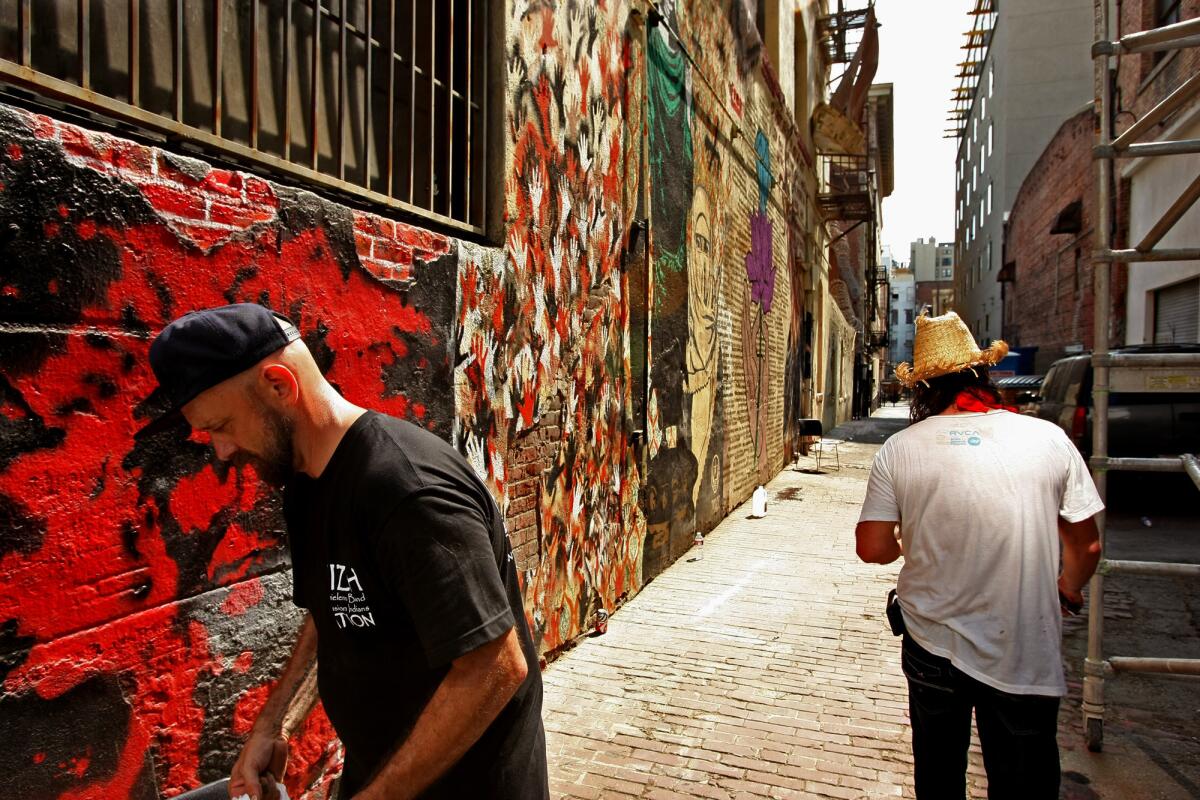
Photographer and artist Stephen Zeigler, left, and artist Wildlife stand inside the historic Indian Alley on Werdin Place in skid row in Los Angeles in 2013.
“You were in the middle of things, but you felt really far away,” recalls artist Marnie Weber, who in those days played with a popular local rock band called Party Boys. “It was a great scene in that you could create your own scene.... People were doing a lot of street performance and loft performances. The expectations were so low. People were happy if 10 people showed up. And there was no talk of making money.”
Tomaselli, says the happenings could get pretty bizarre. He remembers one piece by the now-renowned artist Paul McCarthy at the offices of High Performance, a performance art magazine founded by Linda Frye Burnham.
“Paul was mixing these paints on a Coleman stove while he was wearing a mask — a Richard Nixon mask or a pig mask or something,” he says with a chuckle. “He filled the whole place with fumes. I’m amazed the place didn’t blow up.”
The concentration of artists made downtown an attractive location for galleries of all stripes. In addition to the long-running Cirrus, there were Stella Polaris, Riko Mizuno, Downtown Gallery, Galleria by the Water and Oranges/Sardines, among dozens of others.
There was also a cluster of nonprofit spaces that served as important experimental arts venues. This included the Woman’s Building, which relocated to the outskirts of Chinatown in 1975, and the Los Angeles Institute of Contemporary Art on Traction Avenue.
Significant among these was LACE, which had been established in 1978 by a group of largely Chicano artists, including Gronk, and which first inhabited a space above a bridal shop at the Victor Clothing Co. building on Broadway. (One of Gronk’s early shows there ended in a near riot when revelers and punk bands got out of hand.) In 1986, the organization, moved to larger digs on Industrial Street — next to what is now the tout trendy French restaurant Church & State — to accommodate its growing roster of activities.
LACE was omnivorous in its programming tastes. It held exhibitions of flame-spewing robots designed by Survival Research Laboratories and collaborated with city authorities to raise artist-designed flags in Pershing Square, set to a fanfare devised by composer Carl Stone.
“We were committed to this alternative world outside of the marketplace and outside of the traditional institutions,” says Joy Silverman, who served as the organization’s director for seven years starting in 1983. “Artists could do pieces at LACE, and they could fail. And that was a success, because they got to experiment.”
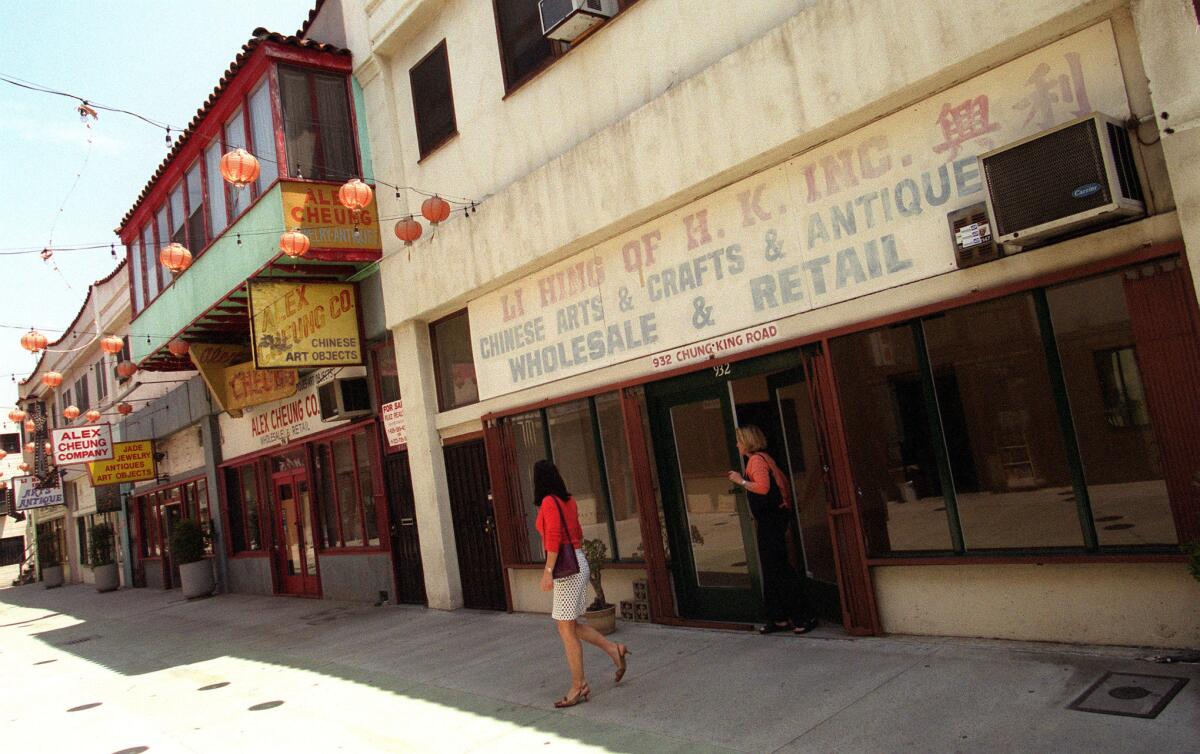
Gallery visitors leave Goldman Tevis on Chung King Road in 2000.
One of the organization’s biggest shows during her time there was a 1984 exhibition at the decrepit Cotton Exchange building on Spring Street (since replaced by the hulking Ronald Reagan State Building).
“It was this totally open show,” recalls Silverman. “Hundreds of artists did pieces there. There were pieces from [the social services nonprofit] Las Familias del Pueblo, from Skid Row providers, from homeless people and prostitutes. People got married at the Cotton Exchange.” Jane’s Addiction played the closing party.
During this time, big “A” institutional art also put a toe in downtown — with the foundation of the Museum of Contemporary Art in 1979, followed by the opening of its two exhibition spaces: the Geffen Contemporary (in 1983) and the museum’s Grand Avenue headquarters (1986).
“That brought a whole other kind of audience,” says Silverman, “more collectors, more people involved in cultural things.”
But nothing lasts forever — and the buzzing downtown scene eventually ebbed because of a confluence of factors. The crack epidemic took its toll, making the desolate streets of the industrial areas more dangerous by day and night. (Tomaselli had a friend who was brutally stabbed.) Government arts funding withered, leading to the decline of some arts space. The 1992 riots, which lapped at the edge of downtown, left many people extra wary of an area that already had a bad reputation because of crack. In 1994, citing fundraising difficulties, LACE moved its headquarters to Hollywood. The art world began to buzz around gallery centers in West Hollywood and Santa Monica.
But downtown has a way of regenerating. Some of the credit goes to the artists who never left. Cirrus stuck it out through thick and thin (though it’s now in a new space on Santa Fe Avenue, after losing its Alameda building to a medical marijuana growing operation). In the late 1990s, other arts spaces began to arrive. There was Action Space, on East 3rd Street, which showed films and hosted live shows, such as body artist Ron Athey‘s seminal 1998 performance “Solar Anus.” And there was a first wave of galleries on Chung King Road in Chinatown, led by China Art Objects, which opened in 1999 (and now operates in Culver City).
Bastions of downtown’s underground spirit remain: Gronk’s assistant, Luis Vasquez, holds regular openings and events in a 3-year-old pop-up art space in his building’s Spring Street lobby called the Lobby Gallery. Instead of punk fliers, it’s promoted via Facebook.
But as desolate downtown has morphed into style-conscious DTLA, pushing out some of the pioneers, the art scene has become ever more high-brow, as evidenced by the arrival of Hauser Wirth & Schimmel. In a way, downtown has gone back to its roots.
“I remember my mother used to work downtown right before World War II,” says Weber. “She would take the trolley downtown and work in one of the offices. It was really fancy then. That’s the beauty of downtown Los Angeles. It’s constantly reinventing itself.”
Find me on Twitter @cmonstah.
ALSO:
The artist who re-created South Pole explorer Ernest Shackleton’s doomed ship on an El Sereno roof
Why you should see Pico Iyer interview globetrotting photographer Sebastião Salgado
You can ask the artist formerly known as ‘Mattress Girl’ artist anything, but Emmatron might answer
With swagger and style, Jose Montoya’s drawings at the Fowler document Mexican American life
More to Read
The biggest entertainment stories
Get our big stories about Hollywood, film, television, music, arts, culture and more right in your inbox as soon as they publish.
You may occasionally receive promotional content from the Los Angeles Times.


